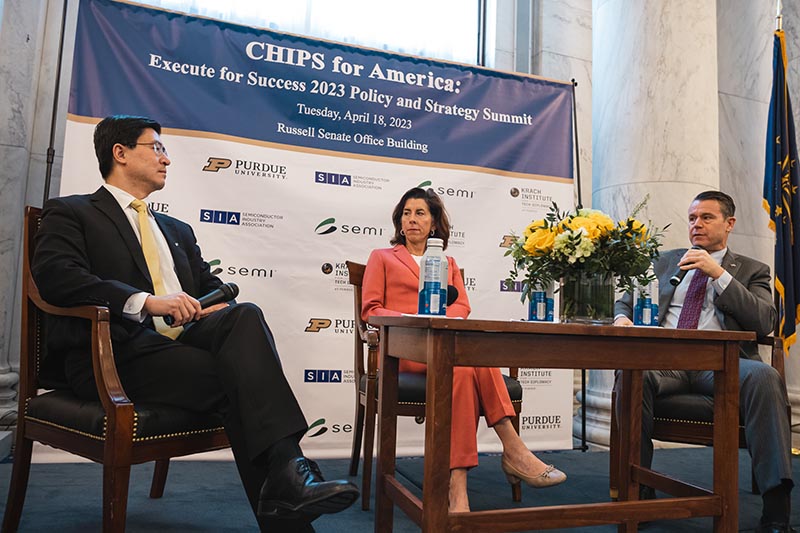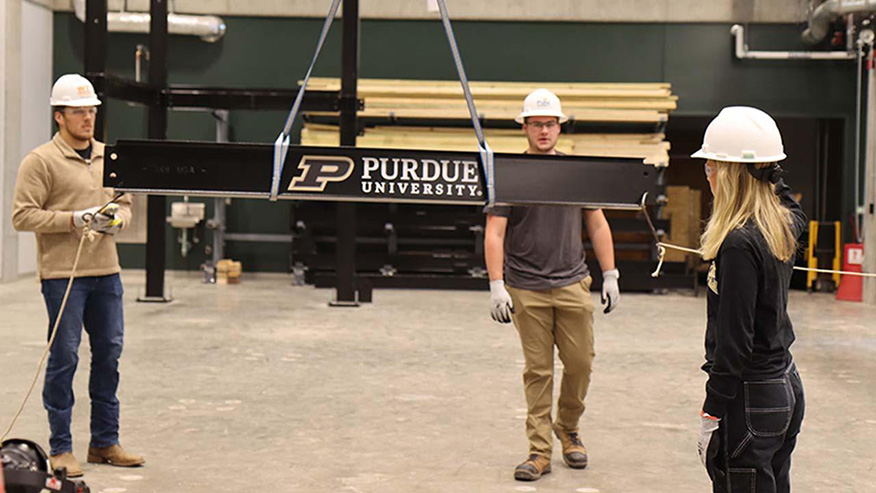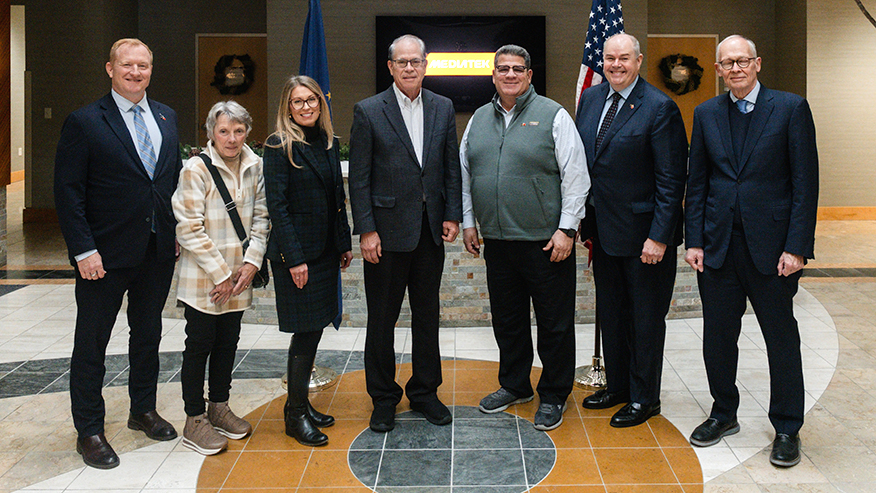Purdue convenes CHIPS summit in D.C. with Sec. Raimondo and Sen. Young, announces sustainability index and facility investment
Board of Trustees approved Phase 1 $49M of the $100M plan for semiconductor research and learning facilities

Purdue University President Mung Chiang, U.S. Commerce Secretary Gina Raimondo, and U.S. Sen. Todd Young of Indiana on stage at the CHIPS for America conference in Washington, D.C., on Tuesday (April 18). (Purdue University photo)
Video: Purdue is leading the way to fulfill U.S. semiconductor needs.
Photo gallery
Podcast
B-roll
WEST LAFAYETTE, Ind. —
Leaders from industry, government and academia convened at a summit Tuesday (April 18) in Washington, D.C. to forge national solutions at scale to address the future of U.S. innovation in microelectronics and the semiconductor workforce.
The full-day CHIPS for America: Execute for Success Summit in Washington, D.C., led by Purdue and U.S. Sen. Todd Young of Indiana at the Russell Senate Office Building in Washington, D.C., convened hundreds of attendees representing over 175 entities from over 23 states, and focused on strategies to execute the vision outlined in the recently released CHIPS for America: Vision for Success. It highlighted the implementation of federal investments and future policy actions, and facilitated the creation of government, industry and academic partnerships with a special focus on workforce development and research innovation.
President Mung Chiang and chief semiconductor officer Mark Lundstrom represented Purdue, which partnered with SEMI, the Semiconductor Industry Association and the Krach Institute for Tech Diplomacy at Purdue, to host the summit.
Keynoting the day, Chiang led a fireside chat with U.S. Secretary of Commerce Gina Raimondo and Sen. Young, and several panel discussions featured leaders from industry, government and academia sharing their perspectives on how to best execute the vision for CHIPS Act workforce development and R&D programs.

“This is our silicon moment, to execute the CHIPS Act for success,” Chiang said. “As we celebrate the 75 years since the invention of transistor in Bell Labs, we can only imagine what the next 75 years of semiconductors innovation might look like.”
Raimondo, who visited Purdue in fall 2022 along with the U.S. Secretary of State Antony Blinken, said at the summit: “I was blown away by what I saw when I visited Purdue, in so far as, in my assessment, it is exactly what the United States needs to be doing. Real robust partnering as between top research universities, like Purdue, and industry, but also the integration of community colleges and also high schools.”
She added: “More people need to continue to do what Purdue is doing: allowing students class credit for applied work at companies, allowing companies to come into the universities, making sure that the students are job ready when they graduate.”
ADDITIONAL INFORMATION
- Purdue University Comprehensive Semiconductors and Microelectronics Program
- A strategic partnership with Dassault Systèmes to improve, accelerate and transform semiconductor workforce development
- European technology leader imec opens innovation hub at Purdue
- The nation’s first comprehensive Semiconductor Degrees Program
- Purdue continues to create unique lab-to-fab ecosystem for the state and country
- Green2Gold, a collaboration between Ivy Tech Community College and Purdue University to grow Indiana’s engineering workforce
Reflecting on last September’s visit to Purdue by Raimondo and Blinken, Young said, “There’s a lot of excitement in the air about what might follow. … What I’ve been encouraged about on the back end of that gathering is that our state has really operationalized many of the opportunities. We’re putting together a tech-hub package. Purdue University and some other institutions are developing new workforce training programs for these key sectors. Indiana is really poised to play a (significant) role as it relates to semiconductors but also any of the other emerging technologies that we need to invest in.”
Other speakers at the summit included Ramin Toloui, assistant secretary of state for the Bureau of Economic and Business Affairs at the U.S. Department of State; Dr. Dev Shenoy, principal director of microelectronics with the U.S. Department of Defense; Dr. Eric Lin, interim director, CHIPS Research and Development, U.S. Department of Commerce; and Dr. Erwin Gianchandani, assistant director of the Technology, Innovation, and Partnerships at the National Science Foundation, as well as leaders from Applied Materials, Everspin Technologies, Information Technology and Innovation Foundation, Intel, Micron, SEMI, the Semiconductor Industry Association, Semiconductor Research Corporation, and SkyWater. They shared their perspectives on the challenges ahead, ways to measure progress and how to sustain the effort over the long term. Barbara Snyder, President of the Association of American Universities, made concluding remarks about the multiple roles a leading research university like Purdue plays in the success of CHIPS Act.

Semiconductor task force and sustainability index
At the beginning of the fireside chat with Raimondo and Young, Chiang announced partnerships with industry to create the Sustainability Capability for Semiconductors Index (SCSI), with the vision of integrating and operationalizing sustainable engineering principles and methods across the entire semiconductor industry. The effort calls for addressing the economic, environmental, and societal dimensions of sustainability in the development of materials, processes, systems, products, supply chains, and enterprises. The sustainable semiconductor manufacturing initiative builds upon decades of expertise and the experience of faculty members from across the university. These includes some of the world’s leading experts on industrial sustainability and semiconductor design/manufacturing.
Carol Handwerker, the Reinhardt Schuhmann, Jr. Professor of Materials Engineering and an environmental and ecological engineering professor, notes that “the initiative leverages ongoing industry engagements with the SEMI Climate Consortium, imec, SkyWater, Seagate, Google, Microsoft, Cisco, etc.” In moving forward, the initiative will undertake sustainability education and workforce development, in addition to improving process and product designs through sustainability-driven research innovations.
Additionally, Purdue announced this week the creation of a Purdue Presidential Semiconductor Task Force led by Lundstrom, the university’s first chief semiconductor officer, which will coordinate and lead Purdue’s efforts toward innovative research and development in semiconductors.
Lundstrom said the CHIPS Act is a once-in-a-generation investment, offering opportunities to bolster continuing faculty work at launching the nation’s largest and most comprehensive workforce development program. It also spurred Purdue plans for new, innovative research programs and its work with the state of Indiana to grow an emerging semiconductor ecosystem.
More than 25 companies that have members on the Purdue Semiconductor Degrees Leadership Board sent industrial representatives to the summit and met with Purdue staff afterward. The board was established to provide visionary input for Purdue’s semiconductors degrees program.
Advancing Purdue’s national leadership: Phase 1 of Semiconductor Facilities Moving Forward
As part of Purdue Computes, a three-pronged strategic initiative launched on April 14 to further scale Purdue’s research and educational excellence in the future of computing, and recognizing that computing takes place in chips, Purdue announced the investment of Phase 1 $49 million in semiconductor cleanroom upgrade and a planned Phase 2 of another $51 million to help create an open innovation ecosystem.

“Birck Nanotechnology Center has for decades been a critical home for discovery and technology development, both for Purdue researchers and those from industry and other universities who use our facilities,” says Zhihong Chen, the Mary Jo and Robert L. Kirk Director of the Birck Nanotechnology Center. “This investment will ensure that we maintain our state-of-the-art facilities, reclaim more space, and establish new capabilities for semiconductor R&D.”
Upgrades will include procurement of specialized equipment for device fabrication and characterization, and effort to increase capacity in the 25,000-square-foot Scifres Nanofabrication Laboratory cleanroom, one of the largest academic cleanrooms in the nation. It will include a dedicated training bay for use in training those enrolled in the university’s Semiconductor Degrees Program, such as Purdue undergrads, Ivy Tech students, and engineers in the field.
The upgrades will also create dedicated cleanroom and lab space for advanced packaging research – innovations in design, materials, and processing that are needed to integrate chiplets with different functionalities – and shared quantum transport and characterization facilities, which are important to future electronic and quantum information science applications. Work will begin immediately and is expected to be completed in August 2024. The installation of new equipment in the renovated space will start in the first quarter of 2024.
“As we continue to push the boundaries of scientific discovery, our commitment to advancing nanoscale science and engineering is unwavering,” says Karen Plaut, executive vice president for research. “Purdue’s investment in our facilities demonstrates our dedication to providing state-of-the-art resources for our esteemed researchers and students, empowering them to advance critical semiconductor technology and engage in groundbreaking research in other areas of nanoelectronics, quantum computing, and more.”
Writer/Media contact: Brian Huchel, bhuchel@purdue.edu



